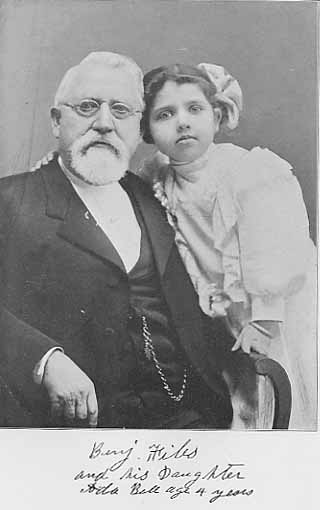
Benjamin Files, a pioneer settler of Fort Scott and one of its most substantial citizens, was born near Cleveland, Ohio, Dec. 27, 1837, son of George and Lydia Files, the father having been a soldier in the war of 1812. In 1843 the little family moved to Michigan and settled on a farm in the unbroken forest. Mr. Files cleared the land, improved it and became a prosperous farmer. Until his twentieth year Benjamin Files lived in the great pine woods of Michigan, with the exception of three years spent in the lumber camps of Canada and on the lakes. He was financially successful, even as a boy, and by the time he was twenty years of age had saved $6,000, with which money he decided to go to the Rocky mountains and prospect for gold. He made the journey from St. Joseph, Mo., to the mountains with horses and a covered wagon. But this venture did not prove profitable and he soon returned to Missouri. Here he heard about the fine lands in Texas and started for the South on horseback by way of Fort Scott. He slept on blankets one night, six miles north of Fort Scott, and coming into the embryo town the next morning he purchased a drink of whiskey from old Judge Morgraves, who was then keeping a saloon in a log cabin where Market street now is. This was some time in the late '50s. Mr. Files had many interesting adventures on this trip. In passing through Indian Territory he was a guest of Lewis Ross, chief of the Cherokee Nation of Indians, and spent one week with Charley Landrum, a half-breed Cherokee. These two Indians were very wealthy and occupied the only houses with plank floors that Mr. Files saw in all the distance from Fort Scott to Red river. Texas lands were very cheap, selling at ten and twenty-five cents an acre, and the principal values were in the long-horn cattle, ponies and negro slaves. After reaching Texas Mr. Files did not like the climate and soon returned to Granby, Mo. Here he engaged for a time in mining and melting lead, which was drawn to Boonville, Mo., by ox teams. Land in the vicinity of the lead mines was selling at ten cents an acre, and mail was delivered only twice a month. After a few months at the lead mines Mr. Files went to Lamar, Mo., where he had charge of a plantation and was also interested in a hotel. On Nov. 6, 1863, his property was destroyed when the notorious Quantrill burned the town. During the Civil war Mr. Files acted as guide to the Union scouts under William Tuffs, chief of the scouts of the Western Division, and conducted them through Arkansas. In the fall of 1862 he came to Fort Scott and engaged in the livery business and freighting. He made a great success and remained in the livery business for twenty-six years. He has always been an admirer of good horses, and was without doubt the most successful liveryman in the State of Kansas. From 1866 to 1868 he ran a stage coach from Fort Scott to Humboldt, Kan., the roundtrip being made three times a week. At this time he owned a number of Kansas farms and the undivided one-half interest in 10,000 acres of land and a saw mill in Arkansas. In 1884 Mr. Files embarked in the brokerage business, which he has continued to pursue to the present time. He has great business ability and has been successful in all his undertakings. At the present time he owns three fine farms, several city properties and extensive personal property.
In 1904 he was married to Ada Belle Dennis, of Bourbon county, Kansas, but a native of Missouri. They have one daughter, Ada Belle. In politics, Mr. Files is a Democrat, was the first marshal of Fort Scott after the close of the war and has served as alderman. When he first came to the city the population was less than 1,000 and there was not a brick building in the town. He has always been identified with every movement for the growth and improvement of Fort Scott, contributed liberally toward the upbuilding of the city and is considered one of its most progressive citizens.
Pages 1304-1305 from volume III, part 2 of Kansas: a cyclopedia of state history, embracing events, institutions, industries, counties, cities, towns, prominent persons, etc. ... / with a supplementary volume devoted to selected personal history and reminiscence. Standard Pub. Co. Chicago : 1912. 3 v. in 4. : front., ill., ports.; 28 cm. Vols. I-II edited by Frank W. Blackmar. Transcribed December 2002 by Carolyn Ward. This volume is identified at the Kansas State Historical Society as microfilm LM195. It is a two-part volume 3.
![]()
TITLE PAGE / LIST OF ILLUSTRATIONS
INTRODUCTION
A | B | C | D | E | F | G | H | I
VOLUME II
TITLE PAGE / LIST OF ILLUSTRATIONS
J | K | L | Mc | M | N | O | P | Q | R | S | T | U | V | W | X | Y | Z
VOLUME III
BIOGRAPHICAL INDEXES
